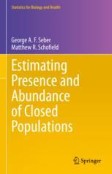Search
Search Results
-
Occupancy models with autocorrelated detection heterogeneity
Occupancy models are commonly used in statistical ecology to model binary detection/non-detection data. These hierarchical models make a distinction...

-
Dynamic occupancy analyses of native birds in an urban ecological reserve reveal seasonal changes in site occupancy and preference for adjacent urbanized areas
Urban ecological reserves are large green areas immersed within cities where native and exotic species of plants and animals coexist. Here, we...

-
A Gibbs sampler for multi-species occupancy models
Multi-species occupancy (MSO) models use detection-nondetection data from species observed at different locations to estimate the probability that a...

-
Using Camera Traps to estimate Habitat Preferences and Occupancy Patterns of Vertebrates in Boreal Wetlands
Wetlands are a critical habitat for boreal mammals and birds that rely on them for breeding, foraging, and resting. However, wetlands in boreal...

-
Occupancy, Abundance, and Related Topics
Models for occupancy, where it is important to determine whether a particular species is present or not, have a long history. The literature is very...
-
Interspecific occupancy-abundance relationship of benthic diatoms changes seasonally with attachment mode in a tropical river
The positive occupancy-abundance relationship (OAR) is considered a ubiquitous pattern and well explained by species niches. However, OAR can change...

-
Patch size and connectivity predict remnant habitat occupancy by an endangered wetland specialist, the salt marsh harvest mouse
ContextThe area-isolation paradigm of metapopulation theory predicts that larger and more connected patches have a higher probability of occupancy....

-
Ecological determinants of spotted hyena Crocuta crocuta occupancy in Comoé National Park, Côte d’Ivoire
Knowledge of the large carnivore guild is important in view of a possible lion reintroduction into the Comoé National Park (CNP), northern Côte...

-
MNase-Seq Analysis for Identifying Stress-Altered Nucleosome Occupancy in Plants
Nucleosome occupancy plays an important role in chromatin compaction, affecting biological processes by hampering the binding of cis-acting elements...
-
Can prey occupancy act as a surrogate for mesopredator occupancy? A case study of ocelot (Leopardus pardalis)
Understanding the trophic structure of carnivore communities leads to improved species management and conservation, particularly in highly...

-
Notable Changes in Conservation Status of Vultures in Uttar Pradesh, India: A Study Based on Occupancy and Habitat Modelling
Vultures are key to the functioning of ecosystems but they are assessed to be threatened globally and their numbers are at-risk due to changes in...

-
Neotropical Mammals and the Analysis of Occupancy and Abundance
Ecology has to do with the number of individuals or species in a biological population or community. Historically, the estimation of population size...
-
Evaluation of anthropogenic pressure on the occupancy patterns of large mammals in the Western and Eastern Ghats
ContextHabitat loss limits the dispersal of wide-ranging large mammals. It is pivotal to study the ecological and anthropogenic factors driving the...

-
Frequent burning and limited stand-replacing fire supports Mexican spotted owl pair occupancy
Changing fire regimes have the potential to threaten wildlife populations and communities. Understanding species’ responses to novel fire regimes is...

-
Big cats like water: occupancy patterns of jaguar in a unique and insular Brazilian Amazon ecosystem
Patterns of detectability and occupation of the jaguar ( Panthera onca ) vary throughout its distribution, being determined primarily by vegetation...

-
Legacy land use predicts occupancy patterns of prairie-associated herpetofauna in Western Arkansas
ContextPrairies historically covered much of inland North America, and many species have adapted to the unique conditions found in prairie...

-
Unraveling a paradox of habitat relationships: scale-dependent drivers of temporal occupancy-abundance relationships in a cooperatively breeding bird
ContextSpatial occupancy and local abundance of species often positively covary, but the mechanisms driving this widespread relationship are poorly...

-
Estimates of wildlife species richness, occupancy, and habitat preference in a residential landscape in New York State
Despite the widespread adoption of motion-triggered camera traps, studies using camera traps to characterize wildlife communities in residential...

-
GCLiPP: global crosslinking and protein purification method for constructing high-resolution occupancy maps for RNA binding proteins
GCLiPP is a global RNA interactome capture method that detects RNA-binding protein (RBP) occupancy transcriptome-wide. GCLiPP maps RBP-occupied sites...

-
Using a novel land cover classification to identify multi-scale drivers of site occupancy for shrubland habitat conservation
ContextUnderstanding habitat selection at multiple scales is important for guiding conservation efforts. This is difficult for species that occupy...

